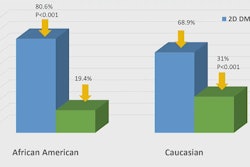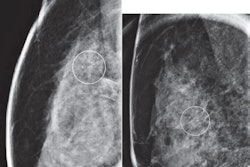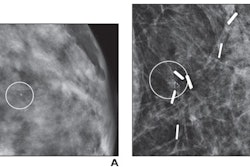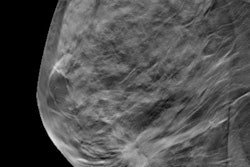The U.S. Food and Drug Administration (FDA) cleared synthetic 2D mammography images for use with digital breast tomosynthesis (DBT) in 2013. But just how effective is the technique?
A team of researchers led by Sona Chikarmane, MD, of Brigham and Women's Hospital in Boston, addressed the question in a literature review published September 28 in RadioGraphics, outlining the pros and cons of synthetic mammography used with DBT compared to full-field digital mammography (FFDM) plus DBT and FFDM alone.
"Synthetic mammography -- that is, the 2D reconstruction of the tomosynthesis slice dataset, has been designed to replace FFDM and potentially eliminate the drawbacks of FFDM plus DBT," the team wrote. "[We reviewed] current literature on synthetic mammography, with a focus on the benefits, drawbacks, and future direction of [it] in mammographic screening and diagnostic settings."
DBT produces 3D images of the breast but requires a 2D image for comparison with prior mammograms and for accurate interpretation of calcifications, the authors noted; synthetic 2D mammography reduces patients' radiation exposure. But synthetic mammography images have been associated with imaging artifacts, higher false positive rates for calcifications, less visibility of asymmetries, and lower breast density assessments.
So just how good is it? Chikarmane and colleagues investigated the technique via a literature review of studies that evaluated the assessment of breast density, calcification detection, and mass detection with synthetic mammography and DBT; FFDM and DBT; and FFDM alone.
The group noted the following pros and cons when it compared synthetic mammography plus DBT to FFDM plus DBT and FFDM alone:
| Performance of synthetic mammography plus DBT compared with FFDM/DBT or FFDM alone |
||
|---|---|---|
| Breast density evaluation |
|
|
| Calcification detection |
|
|
| Detection of masses |
|
|
So what limits the adoption of SM for use with DBT? A perception of reduced image quality, the authors wrote.
"The perceived lower image quality is due to decreased spatial resolution, with phantom studies demonstrating that SM has five line pairs per millimeter versus FFDM alone, which has 11 line pairs per millimeter," they noted. "These differences may allow fine microcalcifications or low-density small masses to be overlooked at screening with SM."
AI will likely be part of the improvement of synthetic mammography images, according to the researchers.
"Vendors are currently working on updated versions of SM," they concluded. "Updated SM algorithms are being designed to recreate 2D reconstructions with sharper, more natural images for improved visualization."
The complete study can be found here.



















